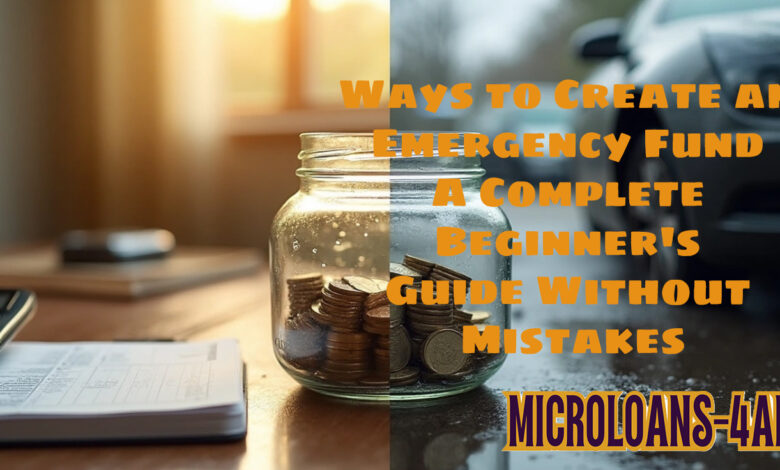Ways to Create an Emergency Fund A Complete Beginner’s Guide Without Mistakes
How to Increase Your Emergency Fund A Perfect Manual for Total Novices

Hello, friends. Welcome to our blog. My name is Max, and if this is your first time visiting our blog, please bookmark it, as we will continually share articles that benefit you and your business. Always make sure to visit our blog from time to time for important articles, such as what we are about to share now.
Greetings, Friends. Did you know that only 41% of Americans had enough money saved up to meet an unforeseen bill of $1,000 or more? It’s more important than ever to learn how to accumulate an emergency fund.
Over half (59%) of Americans are uneasy about their emergency funds, and 46% are concerned that they wouldn’t be able to pay for even a month’s worth of necessities if they lost their job. Even if you have no money to start with, it is still possible to accumulate an emergency fund in spite of these worries.
Given that experts advise putting aside three to six months’ worth of living expenses, we recognize that building emergency funds can feel overwhelming. The good news is that starting small is OK. We aim to assist you in breaking the challenging cycle that results from those who have a hard time recovering from financial shocks often having less money saved for future emergencies.
Regardless of your present financial circumstances, we’ll show you how to build an emergency fund in this tutorial. We have doable steps that everyone can follow, regardless of whether you’re living paycheck to paycheck or just need a better method.
-
Knowing About Emergency Funds:
A financial safety net set up especially for unforeseen costs or financial emergencies, an emergency fund is more than just a savings account. Consider it your financial first aid kit, ready to go when life presents unforeseen difficulties.
Emergency money is essential for several reasons. Above all, they provide a safety net that keeps you afloat in tough times without requiring you to use credit cards or expensive loans. They then give you comfort in knowing that you’re ready for anything that may happen next.
-
What precisely ought to be covered by your emergency fund? Your funds must be prepared for:
Unexpected medical costs
Appliance replacements or home repairs
Major auto repairs
Unexpected veterinary expenses
Costs of living when unemployed
According to research, those who don’t have enough emergency funds frequently find it difficult to bounce back from financial setbacks. As a result, individuals might have to rely on loans or credit cards, which can result in a debt cycle that is hard to break. Further jeopardizing their future financial security, a lot of people without emergency funds wind up taking money out of retirement accounts or other long-term investments.
Financial gurus often advise saving between three and six months’ worth of living costs. However, depending on your situation, this number may change; people in less stable industries may want to strive for a 12-month cushion instead.
For novices, concentrate on beginning modestly. Even $500 can go a long way toward paying a significant bill. After that, keep working toward your bigger objective of covering several months’ worth of expenses.
Where should these funds be kept? The ideal location is somewhere liquid and conveniently accessible, such as a money market, savings, or checking account. Additionally, it’s best to maintain your emergency savings in safe, stable locations rather than investments that change in value based on market conditions, because your main objective is security rather than growth.
In essence, setting up an emergency fund gives you both practical safety and mental comfort by protecting you against monetary instability and mounting debt.
Your emergency reserve should be in proportion to your financial circumstances. Although it’s a simple rule, financial experts advise saving three to nine months’ worth of living expenses. A person may need to save nine to twelve months’ worth of money if they are self-employed, a lone provider, or have inconsistent income.
-
Knowing your financial situation is necessary to determine your personal savings target. Take into account these elements:
Stability of income:
People with erratic incomes could require more savings.
Debt commitments: Your ability to save is impacted by high debt payments.
Expenses per month: Determine your basic expenses, such as housing, utilities, and food.
It’s okay to start small. A $500 savings could go a long way toward paying for an unexpected auto repair or medical expense. Then work your way up to your bigger objective. One strategy is to save $10 every week, which adds up to more than $500 over a year.
-
Where should these funds be kept? Seek out accounts that provide:
Safety (FDIC/NCUA insurance)
Liquidity (easy access with no penalty)
Some interest earnings.
High-yield savings and money market accounts are often effective investments. Both provide FDIC insurance up to $250,000 per depositor and pay more interest than standard accounts.
Money market accounts frequently contain check-writing rights or debit cards for immediate access in an emergency. Meanwhile, high-yield savings accounts often provide competitive interest rates with easy automated transfers to your checking account.
Avoid storing emergency cash in certificates of deposit (CDs) with early withdrawal penalties or investment accounts prone to market volatility. Similarly, retirement accounts such as 401(k)s or IRAs should be avoided for emergency savings due to potential tax consequences.
Online banks frequently provide greater interest rates than traditional brick-and-mortar institutions, but some people prefer the face-to-face service provided by local banks. Firstly, select a solution that provides both security and accessibility.
-
How to Increase Your Emergency Fund
Creating a sustainable emergency fund requires a systematic approach that anyone can follow. Let’s explore practical actions you can take today to start building your financial safety net.
First, set a specific savings goal. Although the end target might be three to six months of expenses, begin with something achievable, like $500 or $1000. This initial milestone motivates us to continue saving.
Start small but remain consistent. Even saving $10 weekly accumulates to over $500 after a year. As one financial expert notes, “Successful saving is all about making it a habit”. The key is regular contributions, regardless of their size.
Examine your budget to uncover potential savings. Look for non-essential expenses that can be transferred to your emergency fund. Keep close track of your costs so you know where every dollar goes.
-
Savings can be automated with remarkable success. Think about:
Setting up direct deposit from your salary into a dedicated savings account
Arrange automated transfers from checking to savings on payday.
Divide your paycheck between checking and emergency savings accounts.
“The beauty of automating is that you’re paying yourself first,” which creates a regular saving habit without the need for willpower each month.
Additionally, take advantage of cash windfalls. When you receive unexpected money, such as tax returns, work bonuses, or monetary presents, set aside a part for your emergency fund. These infrequent surges can help you make great progress.
YOUR TEMake Money in Retirement: Enjoyable and Flexible Business IdeasXT
YOUR TA Beginner's Guide: How to Create an Emergency FundEXT
Ways to Create an Emergency Fund: A Complete Beginner’s Guide Without Mistakes
Gradually raise your investment over time. Increase your savings rate when your income increases or your debts decrease. Consider increasing by 1% intervals until you attain your goal.
Following any emergency withdrawal, you should immediately begin rebuilding your savings. This ensures your financial security for future unforeseen events.
Remember that creating an emergency fund is a journey. Celebrate minor triumphs along the way, and don’t be disheartened if progress appears slow at first. Even having “literally any amount” saved is more secure than having nothing at all.

One of the most crucial stages to financial security is setting up an emergency fund. As we’ve seen throughout this book, even while it’s generally advised to save three to six months’ worth of costs, even as little as $500 can go a long way in unforeseen circumstances.
Everyone experiences financial emergencies, regardless of their degree of income or capacity for preparation. Consequently, establishing this safety net shields you from emotional as well as financial harm. It is incredibly reassuring to know that you can manage unforeseen costs without incurring debt.
Keep in mind that consistency, not quantity, is the key to developing an emergency fund successfully. Over time, modest, consistent donations will add up to significant savings. Furthermore, by automating your savings, you eliminate the temptation to spend the money elsewhere, thereby automating your financial security.
Ways to Create an Emergency Fund A Complete Beginner’s Guide Without Mistakes
We advise putting your emergency funds in money market or high-yield savings accounts that provide both liquidity and a little amount of interest. Most importantly, these accounts ought to offer instant access in the event of a true emergency.
Your financial journey doesn’t need to be perfect. Setbacks will occur, and you might occasionally need to tap into your emergency fund; that is precisely why you created it in the first place! Afterward, simply start rebuilding with the same strategies that worked before.
Financial security doesn’t happen overnight. Nevertheless, each dollar you save brings you closer to the comfort of knowing you’re prepared for life’s unexpected challenges. Start today with whatever amount feels manageable, stay consistent, and watch your financial safety net grow stronger with time.



